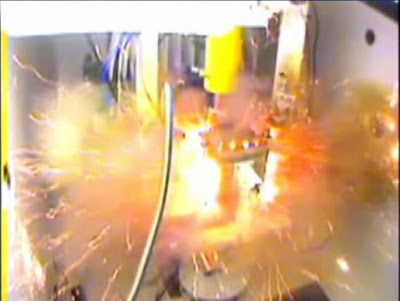Florine is arguably the most volatile and reactive element in the universe. And yet it's in our toothpaste!
When purified fluorine is a pale yellow gas, however it does not stay around very long because it is so reactive. Fluorine will react with almost any element, sometimes in an explosive manner. Under most conditions pure fluorine will burn with other substances on contact, but for other substances (such as hydrogen) it will explode violently. This property makes it extremely difficult to store.
 The reason fluorine is so reactive is found in the shape and behavior of the atomic structure itself. Fluorine is the 9th element on the Table of Elements its atomic number is also 9, which means it has 9 electrons. If you remember learning about the Bohr model of the atom, you might recall that the first electron orbit can contain 2 electrons and the second orbit can contain 8. This means that all but one spot in the outer electron orbit of fluorine is filled.
The reason fluorine is so reactive is found in the shape and behavior of the atomic structure itself. Fluorine is the 9th element on the Table of Elements its atomic number is also 9, which means it has 9 electrons. If you remember learning about the Bohr model of the atom, you might recall that the first electron orbit can contain 2 electrons and the second orbit can contain 8. This means that all but one spot in the outer electron orbit of fluorine is filled.
Now for a little review on molecular structure: in order for atoms to combined themselves into a molecule, they need to share electrons. This happens when one atom's electron fills the "hole" of another. (From hole to whole, get it?) The fewer electron holes an atom has, the more it "wants" to fill them. (This wanting is called electronegativity.)This means that elements like oxygen (which has two holes) is more reactive then elements like carbon (which has four), while elements that have no holes (like helium and neon) are inert and will not form molecules with other elements. This also means that fluorine (with only one hole) really wants that hole filled. When it burns or explodes, what it is really doing is stealing another atom's electron. In fact, fluorine is such a thief it can even steal from some of the noble gases! (The ones with no holes.) However this trick requires some special conditions first, because no one gets away with stealing from the nobles!
Because fluorine is very reactive you might think it is harmful to people, but you would be wrong. Just because an element is reactive does not necessarily mean it is dangerous, as long as it is exposed to the correct area of the body in a semi-stable form. Oxygen and hydrogen are also very reactive, and both are essential to life. Fluorine makes enamel harder and more resistant to decay. A word of cation though: fluorine may cause damage to developing permanent teeth, and will harm you if taken in large doses. City water typically contains less then 2ppm fluoride.
Fun fact: an average human's body contains about 2-3 grams of fluorine.
Sources:
Exploring Creation with Chemistry, Second Edition
World Book Encyclopedia, 1997 Edition.
All pictures courtesy of www.webelements.com



